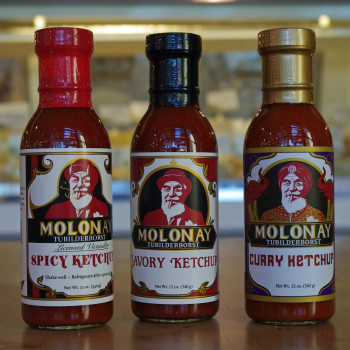In downtown L.A., chef Nick Coe is painstakingly crafting his “Molonay Tubilderborst” ketchups. We asked him to tell us about the complex precursors to the humble condiment, and to defend artisan ketchups when even food snobs seem sold on Heinz.

Rico Gagliano: Why the name Molonay Tubilderborst?
Nick Coe: Well, it’s our character who represents the ketchup. It was actually come up with by this British humorist in the 30’s who specialized in inventing completely off-the-wall names. I wanted something that was unlike all the focus group, corporate-style names that people come up with these days.
Rico Gagliano: Like “Heinz.”
Nick Coe: That would be one, yes.
Rico Gagliano: Let’s get a little background about ketchup. Where did it come from?
Nick Coe: Well, the origins of ketchup they think, probably was some sauce in Southeast Asia that British traders tasted back in the 17th century. The original one was probably something more like fish sauce than what we think of as ketchup today. And when they went back to England, they tried to reproduce those flavors using their local ingredients. So they had things like anchovies, walnuts, mushrooms, shallots… all these different sort of savory, strong-flavored ingredients.
Rico Gagliano: That actually sounds amazing.
Nick Coe: Some of those original ketchups were probably amazing. And they still make mushroom ketchup in England.
Rico Gagliano: But we think of it as a tomato-based thing. How does that happen?
Nick Coe: It’s hard to say why tomato took over all the other ketchups, except that tomatoes go really well with not just savory spices, but also with some of the sweet spices like cinnamon, allspice, and cloves — which are the classic spices in ketchup. It’s a very sort of broad palette that tomato allows you to use, and it goes with a very broad range of foods.
Rico Gagliano: I read somewhere that that’s the genius of ketchup, and specifically Heinz ketchup. Before people talked about, say, the concept of “umami,” — it was umami. It had bitter, it had sweet, it had umami, it had sour… all of these flavor points.
Nick Coe: Yes it does. And the story of Heinz is, originally ketchup in the 19th century — when tomato ketchup became really popular — was a lot less sweet and a lot less vinegary. But the problem that they had was that when they put the stuff in bottles commercially, it would start to ferment in the bottles, and even explode in peoples’ shelves. So, obviously a problem.
Rico Gagliano: Sounds exciting.
Nick Coe: Well it was a little too exciting — you know, shrapnel as you walk down the aisle.
So they started to use all these different artificial preservatives back in the 19th century. And Heinz figured out a way to use nothing but vinegar, so that the ketchup was sanitary and stable in the bottle without using artificial ingredients. They upped the amount of vinegar enormously to make that work, and in order to balance out the vinegar they added sugar. And that sweet and vinegary flavor that we know as Heinz today comes from them trying to pull artificial preservatives out of the ketchup.
The next thing that happened was, coincidentally, fast food started to become popular in this country. French fries, hamburgers… fried, greasy. And in order to balance out the flavor, instead of needing something that was very complex and had a lot of elements going on in it, you could actually get away with something really simple. And that’s the flavor of Heinz.
Rico Gagliano: Spoken like somebody who’s in competition with Heinz! But this is a question that’s being asked a lot in food blogs and stuff: Why do we need anything more than Heinz? People even in very high-end restaurants have been saying, you know, “We tried making our own homemade ketchups, we make everything else homemade, but for whatever reason, people really like Heinz. It’s what they expect, it works.” Why should we not have Heinz? Why do we need your product, I guess?
Nick Coe: I suppose for the same reason we don’t all drink Budweiser and drive Chevrolet Citations and wear Dockers. Because there is something better than the giant industry-crushing behemoths.
Rico Gagliano: But the people saying this are the kinds of folks that normally would reject corporate behemoths. But there’s just this one thing that they say, “You know, you can’t do any better than Heinz.”
Nick Coe:
One thing about ketchup is, it’s a lot harder to make than people realize.If you follow the old recipes — which is what I did, I went back and found all these 19th century recipes including an old family one — they have a lot of very complex sort of ingredients that all have to be balanced out into it. The reason most people’s homemade ketchups — including most chef’s homemade ketchups 0– fall down, is because to get it right, it takes months and months and months of experimentation.
Rico Gagliano: All right, well, let’s try some of these. You have three different flavors out here. I guess I should start with the classic.
Nick Coe: Let’s start with the savory, that’s the classic flavor. This is how ketchup used to taste in the 19th century.
Rico Gagliano: Oh, that’s really good. I could almost eat that raw! It’s about as thick as ketchup that I’m used to. A little peppery-er. It does have that vinegar punch to it, but it has almost the quality of a gazpacho. Am I out of my mind saying that?
Nick Coe: Some of the things that are in gazpacho are in this. And you’re also feeling the texture difference. This has a rougher texture, whereas most ketchup, they run it through this machine called a finisher, which gives it that kind of whipped, pudding-y, almost slimy texture that you associate with ketchup.
Rico Gagliano: I don’t know that I’d say slimy, but I know what you’re saying. All right, I’m gonna try the spicy while we’re at it.
I would say it’s maybe sriracha-level heat. That’s good! What would you put this on?
Nick Coe: This is the one that I put on hamburgers, but it’s also quite good with seafood, because it’s sort of reminiscent of cocktail sauce.
Rico Gagliano: Oh yeah! What is the difference between ketchup and cocktail sauce by the way?
Nick Coe: Not much. Basic cocktail sauce is chili sauce, which is a type of ketchup that has more peppers… and then you add horseradish, Worcestershire sauce, and lemon juice.
Rico Gagliano: I’m never buying cocktail sauce again, because I have all those things in my refrigerator.


